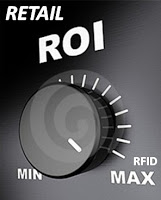As we are near the end of 2012, let's start this week's discussion by revisiting the Apparel Magazine 2013 RFID retail predictions that were published in the October personal post "RFID's Moment of Retail Truth" (1):
- 2013 will be the year of the "Specialty Retailer" with a noticeable proliferation of RFID implementations.
- At least 3 more North America department stores chains will announce rollouts
- The first significant activity by big box athletic retailers will materialize.
- Next generation store infrastructure solutions (hands free) will continue to struggle to gain a foothold in stores.
- Sewn in tags and encased plastic hard tags will see greater usage as RFID data carriers.
Based on new RFID industry data distributed last week, it is time to revisit this technology and discuss the real ROI opportunities for retail. A couple of weeks ago, the web portal "RFID 24-7" published the article "Momentum Builds for Retail RFID in 2013." Highlights included (2):
- For 2012, retail companies cited as having activity with item level RFID included Walmart, JC Penney, Macy's, American Apparel, Canada's Daniel Leather, and Spanish retailer Zara.
- RFID tagging in 2013 will expand from apparel to fragrances, cosmetics, and electronics.
- According to research from IDTechEx, systems and tag business associated with apparel RFID will grow at double the rate of the overall RFID market for the next 10 years.
- Frost & Sullivan reports that the RFID retail market wil grow from $289 million in 2011 to $3.2 Billion in 2017.
- In Russia, a consortium of companies is looking at retail RFID with focus on tagging food items.
- Enhanced benefits will include better inventory management, improved operational efficiency, reduced labor, greater visibility, information accuracy, higher sales, and enhanced customer service.
As multiple posts have previously pointed out, focusing only on the technology and not on the problem it is trying to solve is a recipe for failure. This summer, IHL published an updated study on retail inventory distortion (3).
- Inventory distortion is comprised of both out-of-stocks and overstocks. In 2011, total inventory distortion losses globally were $818 Billion.
- Out of stocks totaled $456 Billion (56% of the problem) and overstocks totaled $362 Billion (46%).
- Apparel and electronics retailers are the most challenged with out of stock inventory issues. 30.8% of the time shoppers leave apparel stores without finding the product they were looking for. For electronic stores this rate is 30.3%.
- Real time inventory is a key problem and annual inventories can be off up to 30% of the time.
- The kiss of death for consumers is when they order something on line for pickup at the store, get confirmation that it is there, go to the store, and the item is not there. In an apparel store, 61.5% of shoppers said they would never shop at that store again.
The data from the IHL study very clearly points to where the real ROI can be found in retail RFID. It starts with clear focus on driving inventory visibility and accuracy in the store. It ends profitably at omni channel retailing.
In 2012, Tyco Retail Solutions issued a white paper titled "Inventory Intelligence, Unlocking Onmi-Channel Retailing and the Future of the Store". Key insights from that white paper (4):
- Onmi-channel retailing allows browsing and ordering from any channel, but focuses on increasing the shopper's spend -- and that means bringing the shopper to the store.
- Onmi-channel retailing recognizes stores' compelling physical and interpersonal advantages, and links them to the high-speed world of electronic retailing. But it places shoppers, not stores, at the center, extending traditional measurements like in-store sales to include revenue per shopper, measured across all retail channels.
- Onmi-channel retailing helps cultivate deep consumer relationships -- explicitly through cross channel loyalty programs and implicitly by building an experience of satisfying shopper experiences.
- Onmi-channel raises shoppers' expectations with a promise of availability. Breaking that promise affects all channels and compromises the brand.
- Integrated inventory intelligence is essential to deliver on the onmi-channel promise.
Retailers that are focused on the "Real ROI in Retail RFID" are not fixated about RFID as a technology. They are responding to the increased pace of retail change where the definition of the store is no longer only the physical brick and mortar building. Mobility, social media, growing internet shopping make it possible to shop in a 24 hour cycle, often by instantly reacting to increased social stimuli from interacting with an ever increasing global circle of friends. Retailers that make all their physical inventory assets available for sale, no matter where they are located, have a clear advantage in fulfilling the faster pace of demand from connected consumers. Inventory visibility and accuracy are the foundation elements for this faster journey.
Retailers that are focused on the "Real ROI in Retail RFID" clearly understand that the technology journey to improve store operations is best approached through a series of adoption layers, each delivering core ROI elements that drive further investments to continuously improve performance. Multiple of the global retailers that are successfully deploying RFID to improve inventory visibility and accuracy are primarily focused on the following two initial technology layers:
- Planning and Allocation - This should always be the start of the onmi-channel foundation journey. In this technology deployment phase, the focus is on improving store replenishment, reducing safety stock, and reducing store out of stocks. With RFID, this approach allows for a lower cost entry to substantial benefits. Deployments typically includes RFID enabled hand helds, RFID swing tickets and / or single-dual technology RFID enabled hard tags.
- On Floor Availability - The next step of the journey is having clear visibility of all the inventory available both on the sales floor and in the backroom. With RFID, this can include adding transitional portals between sales floors and back room.
Opportunity exists for continual improvement beyond these two initial deployment stages. In future posts, we will discuss three additional technology deployment layers for RFID (including Loss Prevention). Focusing on all five layers of RFID technology at the same time is a not a recipe for success. The reasons are very simple. Each additional technology deployment layer adds complexity and more importantly cost. The intensified cost structure means an extended ROI model. In today's retail environment, a longer ROI is a major challenge.
Will 2013 be the breakthrough year for RFID technology as predicted at the beginning of this post? No if the focus is on the technology. A resounding yes, if the focus is on layered RFID deployment towards onmi-channel retailing.

(1) http://ow.ly/fWjtl (2) http://ow.ly/fWk8O (3) http://ow.ly/fWp1V (4) http://ow.ly/fWKYe

















